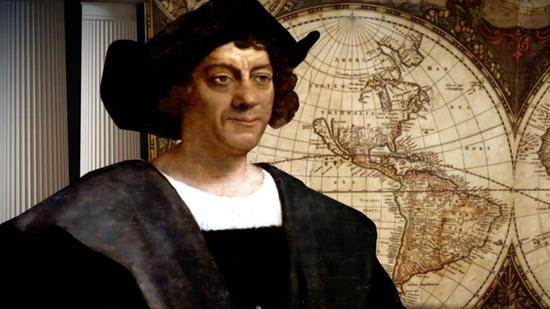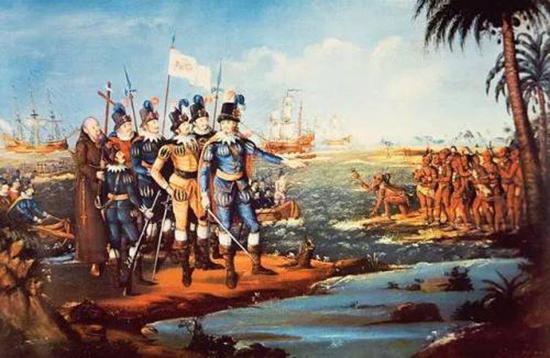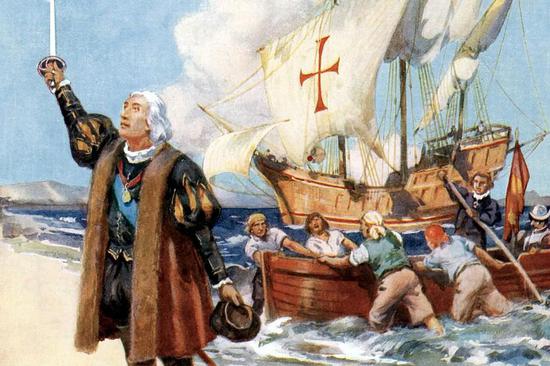西班牙研究人员将开始通过DNA检测,正式确定航海家哥伦布的出生地。尽管历史学家大多认为哥伦布出生于意大利,但这一观点长久以来存在争议。西班牙格拉纳达大学将通过检测哥伦布及其亲属遗骸的DNA,来为这一争议画上句号。DNA样本也会在欧美实验室进行同步检测,结果预计于今年10月公布。

DNA study seeks to end dispute on where Columbus was born
Spanish researchers set out on Wednesday to settle the dispute over the true origins of Christopher Columbus after various theories in the past decades claimed the explorer hailed from Portugal or Spain, rather than Italy, as most scholars agree.
来自西班牙的研究人员周三开始解决关于哥伦布真正起源的争议。过去几十年来,各种理论认为这位探险家来自葡萄牙或西班牙,而非大多数学者认为的意大利。
"There is no doubt on our part (about his Italian origin), but we can provide objective data that can ... close a series of existing theories," Jose Antonio Lorente, lead scientist of the DNA study at the University of Granada, told a video news conference.
格拉纳达大学(University of Granada)DNA研究的首席科学家约瑟•安东尼奥•洛伦特(Jose Antonio Lorente)在一次视频会议中说:“格拉纳达大学负责DNA研究的首席科学家何塞•安东尼奥•洛伦特在一场视频新闻发布会上说:“(关于哥伦布的意大利血统)毫无疑问,但我们可以提供客观数据……证明一系列现有的理论是正确的。”
Historians believe Columbus was born in Genoa in 1451.
历史学家认为,哥伦布于1451年出生在热那亚。
The university hosted a meeting of proponents of alternative theories about Columbus' birthplace, that include Spain's Valencia, Espinosa de Henares, Galicia and Mallorca, Portugal's Alentejo region and a few other places.
该大学举办了一场会议,会议上持有不同理论的支持者们认为哥伦布的出生地包括西班牙的瓦伦西亚、埃斯皮诺萨•德赫纳雷斯、加利西亚和马略卡岛、葡萄牙的阿连特霍地区和其他一些地方。
注释:
proponents:倡导者; 支持者; 拥护者;
例句:But proponents think modules help some state schools to raise their game.
但是支持者认为模版能帮助一些公立学校提高他们的竞技状态。
"I hope (with this research) we will come to the conclusion that unites us in our common objective, which is to demonstrate that Columbus was a Spanish nobleman and not a Genoese sailor," said Alfonso Sanz, an amateur history researcher and author, who says Columbus was born in Espinosa de Henares in central Spain.
“我希望通过本研究可以得出我们共同希望的结论,那就是哥伦布其实是西班牙贵族,而非热那亚水手,”业余历史研究人员兼作者阿方索•桑兹说,他认为哥伦布出生于西班牙中部的埃斯皮诺萨•德•埃纳雷斯。
注释:
nobleman:出身高贵的人; 贵族成员;
The results of the final stage of DNA research on tiny samples of what scientists believe are the remains of Columbus, his son Fernando and his brother Diego, will be analyzed independently by laboratories in Europe and the Americas, and should be published in October.
欧洲和美洲的实验室将对科学家们认定的哥伦布本人及他的儿子费尔南多(Fernando)和他的兄弟迭戈(Diego)的遗骸的少量样本进行独立的DNA分析,研究的最后结果将于10月发表。
The first samples were collected in 2004-2005 and the DNA analysis will now resume after a 16-year hiatus due to technology challenges, which meant too much of the precious sample material would be wasted in exchange for too little data.
第一批样本是在2004-2005年收集的,由于技术问题,DNA分析将在中断16年后恢复,这意味着太多宝贵的样本材料将被浪费,最终只能得到少量的数据。
注释:
hiatus: 间断; 停滞; 空隙;
例句:There was a hiatus in his acting life. 他的演艺生涯曾一度中断。
Columbus died in Valladolid in Spain in 1506, but wished to be buried on the island of Hispaniola that is today shared by the Dominican Republic and Haiti. His remains were taken there in 1542, then moved to Cuba in 1795 and then to Seville in 1898.
哥伦布于1506年在西班牙的巴利亚多利德去世,他本人希望被葬在今天由多米尼加共和国和海地共属的伊斯帕尼奥拉岛上。他的遗体于1542年被带到那里,然后于1795年被转移到古巴,然后于1898年转移到塞维利亚。

10 Things You May Not Know About Christopher Columbus
关于哥伦布你不知道的10件事
1. Columbus didn’t set out to prove the earth was round.
Forget those myths perpetuated by everyone from Washington Irving to Bugs Bunny. There was no need for Columbus to debunk the flat-earthers—the ancient Greeks had already done so. As early as the sixth century B.C., the Greek mathematician Pythagoras surmised the world was round, and two centuries later Aristotle backed him up with astronomical observations. By 1492 most educated people knew the planet was not shaped like a pancake.
1、哥伦布并非为了证明地球是圆的而出发。
忘记那些传说,从华盛顿•欧文(Washington Irving)到兔八哥,大家都是以讹传讹。哥伦布无须揭穿地球是平的这一说法——古希腊人已经这样做了。早在公元前6世纪,希腊数学家毕达哥拉斯(Pythagoras)就猜测地球是圆的,两个世纪后,亚里士多德利用天文观测结果对其表示支持。到1492年,大多数受过教育的人都知道地球的形状并非像个煎饼。
注释:
debunk:批判; 驳斥;
例句:His theories have been debunked by recent research. 最近的研究揭穿了他的理论的真相。
2. Columbus was likely not the first European to cross the Atlantic Ocean.
That distinction is generally given to the Norse Viking Leif Eriksson, who is believed to have landed in present-day Newfoundland around 1000 A.D., almost five centuries before Columbus set sail. Some historians even claim that Ireland’s Saint Brendan or other Celtic people crossed the Atlantic before Eriksson. While the United States commemorates Columbus—even though he never set foot on the North American mainland—with parades and a federal holiday, Leif Eriksson Day on October 9 receives little fanfare.
2. 哥伦布可能不是第一个横渡大西洋的欧洲人。
人们认为,北欧海盗列夫•埃里克森(Leif Eriksson)在公元1000年左右之前就曾经到过如今的纽芬兰岛,这比哥伦布启程早了大约5个世纪。一些历史学家甚至认为爱尔兰的圣布伦丹(Saint Brendan)或其他凯尔特人穿越大西洋的时间先于埃里克森。哥伦布从未在北美大陆留下足迹,但在美国人们会以游行纪念他,还有法定假日,但10月9日的列夫•埃里克森日却冷冷清清。
注释:
Newfoundland:纽芬兰岛(英语:Newfoundland Island,法语:Terre-Neuve),意指“新寻获之地”,是北美大陆东海岸的大西洋岛屿。
3. Three countries refused to back Columbus' voyage.
For nearly a decade, Columbus lobbied European monarchies to bankroll his quest to discover a western sea route to Asia. In Portugal, England and France, the response was the same: no. The experts told Columbus his calculations were wrong and that the voyage would take much longer than he thought. Royal advisors in Spain raised similar concerns to King Ferdinand and Queen Isabella. Turns out the naysayers were right. Columbus dramatically underestimated the earth’s circumference and the size of the oceans. Luckily for him, he ran into the uncharted Americas.
3. 三个国家不支持哥伦布远航。
哥伦布花了近10年的时间,游说欧洲各国为他开辟通往亚洲的新航路提供资助。不过在葡萄牙、英格兰和法国,答案都是一样的:不。 专家告诉哥伦布他的计算是错误的,航行需要的时间比他预想的更久。西班牙皇家顾问也向国王裴迪南和女王伊莎贝拉提出了相似的问题。事实证明这些反对者是正确的。哥伦布大大低估了地球的周长和海洋的大小。幸运的是,他闯进了一个未知的美洲。
注释:
lobby:游说(从政者或政府);
bankroll: 资助; 提供资金给
4. Nina and Pinta were not the actual names of two of Columbus' three ships.
In 15th-century Spain, ships were traditionally named after saints. Salty sailors, however, bestowed less-than-sacred nicknames upon their vessels. Mariners dubbed one of the three ships on Columbus’s 1492 voyage the Pinta, Spanish for “the painted one” or “prostitute.” The Santa Clara, meanwhile, was nicknamed the Nina in honor of its owner, Juan Nino. Although the Santa Maria is called by its official name, its nickname was La Gallega, after the province of Galicia in which it was built.
4. 哥伦布舰队的三艘船其中两艘的实际名字并非尼娜号(Nina)和平塔号(Pinta)。
15世纪,西班牙的传统是以圣徒的名字来命名船只。不过为了有趣,水手们会给他们的船只起一些不那么神圣的昵称。哥伦布1942年启程的舰队有3艘船,其中一艘被水手们戏称为平塔号,在西班牙语中的意思是“涂了油漆的”或者“妓女”。 与此同时,圣克拉拉号(Santa Clara)被戏称为“尼娜”,以纪念其主人胡安•尼诺(Juan Nino)。圣玛丽亚号(Santa Maria)为官方名称,它的绰号是拉•加列加号(La Gallega),标志着这艘船的产地是加利西亚省(Galicia)。
注释:
salty:这里是指有趣的; 逗笑的; 有趣而略嫌粗俗的;
bestow:(将…)给予,授予,献给;
The Queen has bestowed a knighthood on him. 女王已经授予他爵士头衔。
5. The Santa Maria wrecked on Columbus' historic voyage.
On Christmas Eve of 1492, a cabin boy ran Columbus’s flagship into a coral reef on the northern coast of Hispaniola, near present-day Cap Haitien, Haiti. Its crew spent a very un-merry Christmas salvaging the Santa Maria’s cargo. Columbus returned to Spain aboard the Nina, but he had to leave nearly 40 crewmembers behind to start the first European settlement in the Americas—La Navidad. When Columbus returned to the settlement in the fall of 1493, none of the crew were found alive.
5. 圣玛丽亚号失事。
在1492年的圣诞夜,一个船员把哥伦布的旗舰开到了伊斯帕尼奥拉岛(Hispaniola,靠近现在的海地角)北部海岸,撞上了那儿的珊瑚礁。船员们在打捞圣玛丽亚的货物中,度过了一个不甚开心的圣诞节。哥伦布乘着尼娜号返回西班牙,但是他不得不将近40名船员留下来,在美洲的拉纳维达得(La Navidad)建立第一个欧洲殖民地。1493年秋,哥伦布回到这个殖民地时,所有的船员都已去世。

6. Columbus made four voyages to the New World.
Although best known for his historic 1492 expedition, Columbus returned to the Americas three more times in the following decade. His voyages took him to Caribbean islands, South America and Central America.
6. 哥伦布4次抵达新大陆。
尽管哥伦布以1492年的远航而闻名于世,但在接下来的10年中,他曾3次回到美洲。他的航行到达了加勒比群岛、南美洲和中美洲。
7. Columbus returned to Spain in chains in 1500.
Columbus’s governance of Hispaniola could be brutal and tyrannical. Native islanders who didn’t collect enough gold could have their hands cut off, and rebel Spanish colonists were executed at the gallows. Colonists complained to the monarchy about mismanagement, and a royal commissioner dispatched to Hispaniola arrested Columbus in August 1500 and brought him back to Spain in chains. Although Columbus was stripped of his governorship, King Ferdinand not only granted the explorer his freedom but subsidized a fourth voyage.
7. 1500年哥伦布戴着镣铐返回西班牙。
哥伦布对伊斯帕尼奥拉岛的治理近乎残暴。岛上没有收集足够黄金的本地居民要被砍断双手,反抗西班牙殖民者的居民被处以绞刑。殖民者向西班牙王室抱怨管理不善,1500年8月,派往伊斯帕尼奥拉岛的皇家特派员逮捕了哥伦布,并把他铐着带回了西班牙。尽管国王裴迪南免去了哥伦布的州长一职,但他不仅放哥伦布自由,还为哥伦布的4次航行提供资金。
8. A lunar eclipse may have saved Columbus.
In February 1504, a desperate Columbus was stranded in Jamaica, abandoned by half his crew and denied food by the islanders. The heavens that he relied on for navigation, however, would guide him safely once again. Knowing from his almanac that a lunar eclipse was coming on February 29, 1504, Columbus warned the islanders that his god was upset with their refusal of food and that the moon would “rise inflamed with wrath” as an expression of divine displeasure. On the appointed night, the eclipse darkened the moon and turned it red, and the terrified islanders offered provisions and beseeched Columbus to ask his god for mercy.
8. 月食可能拯救了哥伦布。
1504年2月,绝望的哥伦布被困在牙买加,一半的船员都抛弃了他,岛民不给他食物。他的航行全靠天定,而这次,上天又保其安全。哥伦布通过历书了解到,1504年2月29日将发生月食,他警告岛民,上帝对岛民不给他食物的行为表示不悦,月亮会“因愤怒变红”以表达上帝的不满。 到了约定的那天晚上,月食真的发生了,月色昏暗,变成红色,害怕的岛民给哥伦布提供了食物,哀求他请求上帝的原谅。
注释:
almanac:年鉴; 历书; 年历
divine: 天赐的; 上帝的; 神的
9. Even in death, Columbus continued to cross the Atlantic.
Following his death in 1506, Columbus was buried in Valladolid, Spain, and then moved to Seville. At the request of his daughter-in-law, the bodies of Columbus and his son Diego were shipped across the Atlantic to Hispaniola and interred in a Santo Domingo cathedral. When the French captured the island in 1795, the Spanish dug up remains thought to be those of the explorer and moved them to Cuba before returning them to Seville after the Spanish-American War in 1898. However, a box with human remains and the explorer’s name was discovered inside the Santo Domingo cathedral in 1877. Did the Spaniards exhume the wrong body? DNA testing in 2006 found evidence that at least some of the remains in Seville are those of Columbus. The Dominican Republic has refused to let the other remains be tested. It could be possible that, aptly, pieces of Columbus are both in the New World and the Old World.
9. 即使濒临死亡,哥伦布也在继续穿越大西洋。
1506年,哥伦布去世后,葬在西班牙的巴利亚多利德(Valladolid),然后又被移到塞维利亚。应他儿媳的要求,哥伦布和儿子迭戈(Diego)的遗体被运往大西洋彼岸的伊斯帕尼奥拉岛,并被埋葬在圣多明各大教堂(Santo Domingo cathedral)。1795年,法国占领该岛,西班牙人挖出被认为是哥伦布的遗物,将他们转移到了古巴。1898年美西战争之后又还回到塞尔维亚。然而,1877年,一个装有人类遗骸和哥伦布名字的盒子在圣多明各大教堂被发现。西班牙人挖出的遗体不对吗?2006年的DNA测试可以证明,在塞维利亚的遗物有一些是哥伦布的。多米尼加共和国拒绝让其他遗物参与测试。哥伦布的遗物非常有可能遗落在新旧两个大陆。
10. Heirs of Columbus and the Spanish monarchy were in litigation until 1790.
After the death of Columbus, his heirs waged a lengthy legal battle with the Spanish crown, claiming that the monarchy short-changed them on money and profits due the explorer. Most of the Columbian lawsuits were settled by 1536, but the legal proceedings nearly dragged on until the 300th anniversary of Columbus’ famous voyage.
10. 哥伦布后人和西班牙王室的诉讼直到1790年才结束。
哥伦布死后,他的继承人开始了与西班牙王室漫长的法律诉讼,称西班牙王室因哥伦布的原因亏待了他们。1536年前,大部分关于哥伦布的诉讼都已得到解决,但法律程序却一拖再拖,直到哥伦布航海300周年。